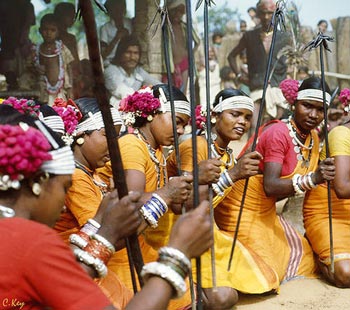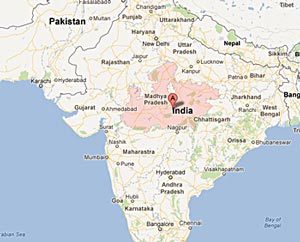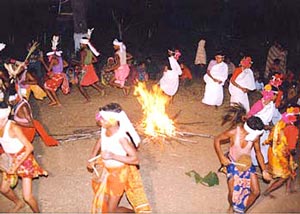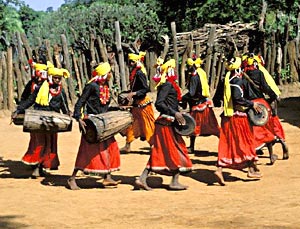| English Page |
Indigenous Peoples of Madhya Pradesh sound the Alarm |
 |
 |
| 11 July 2012 | ||||
The protest against a disturbing new ecotourism scheme in Madhya Pradesh, India
A consortium of indigenous and non-governmental organizations have sounded the alarm over a disturbing new ecotourism scheme by the Madhya Pradesh Forest Department (MPFD). The MPFD, a government agency responsible for managing all forest areas in the central Indian state of Madhya Pradesh, says it wants to lease out 50 to 150 sq km bricks of land to interested tourism companies who would then be free to change the livelihoods of Indigenous Peoples to something more 'compatible' with conservation. The All India Forum of Forest Movements (AIFFM) and the Campaign for Survival and Dignity (CSD), a federation of tribal and forest dwellers' organizations in India--have strongly condemned the heartless and clearly illegal scheme. The Madhya Pradesh Forest Department has recently released a rather strange and rather alarming document ‘Development of Ecotourism Forests, Through Public-Private-Partnership (PPP) for Conservation of Wildlife in MP’. Apparently, the document has originated from the MP forest department, and it tries to present a policy framework for leasing out the state’s forest areas to private tourism businesses. The paper is an alarming attempt to justify effectively giving away forests to the companies for their management. The argument for this – in the form of sweeping and generalized statements on forest degradation - is that local communities and their “extractive overuse” are the main cause of the “destruction of forests and wildlife”. Therefore, the document proclaims, blocks of 50 – 150 sq km each will be reserved in the name of interested tourism companies, who will apparently change the livelihood of forest dwellers to “non-consumptive” forms.
Along the way, the document indulges in attacks on the Forest Rights Act and vague statements about how tourism benefits conservation. Though the policy says that the local people’s use of forests will not be affected from the ‘reserving’ arrangement, the operator ‘shall be free to come to an agreement’ with the local people to change their forest use practices. This is blatant propaganda on behalf of the tourism industry and pushed by the MP forest department. The ‘decline in forest’ extent and quality’ did not happen because of the rural population’s dependence on forests but because the forest policies originally framed by colonial foresters had directly resulted in clearing most of the natural forests in India. This has even been accepted by the Central government in the historic preamble to the Forest Rights Act. One also needs to remember that the FRA is a legitimate piece of statute which applies to the state of MP and its forest department as well. Surely the duty of the forest department of the state lies in ensuring that the Central Act is duly complied with, instead of censuring it in a policy document? Regeneration of degraded natural forests has happened best in cases where forest dependent people were able to meet their ‘consumption’ needs reasonably fully from the forests. There are many good examples of this across the country; evidently, the writers of this policy did not bother to take those into account. Organised wild life tourism in India and elsewhere has largely succeeded in disenfranchising local communities, in many cases doing serious social and ecological damage.
In Africa, exclusive access given out to tour operators ( known as ‘concessions’) resulted in serious and continued violations of community rights, and one of the major policy decisions the post-apartheid South Africa had taken was to return some of biggest concessions to the communities. The tourism industry in India is notorious for exploitation of local communities and for non-sharing of revenue. Expansion of tourism is likely to impoverish local communities further – especially when private operators will be given de facto management powers over stretches of forest. Such granting of exclusive rights amounts to handing over the management of the forest to these companies, in violation of people's rights, the powers of the gram sabhas under the FRA and PESA, and the Forest Conservation Act. We are at a loss to understand how such a poorly written and unsubstantiated document can emanate from a government department, especially a document that either ignores or prescribes bypassing of all existing laws, in the sole interest of promoting private business in forests. We demand an immediate withdrawal of this dubious ‘policy document’. Any attempts to implement this policy will not only be a violation of the law, but will also result in escalating conflicts in forest areas. The forest communities of MP will under no circumstances let their ancestral forests be sold to business houses or such other vested interests. About Madhya Pradesh Madhya Pradesh is the second largest Indian state in size with an area of 308,000 sq km. The forest area of the state is 94,689.38 sq km constituting 30.71% of the geographical area of the state. There are 9 National Parks and 25 Sanctuaries spread over an area of 10,862 sq. km constituting 11.40% of the total forest area. The national parks are: Bandhavgarh, Kanha, Satpura, Sanjay, Madhav, VanVihar, Mandla Plant Fossils, Panna and Pench. The wildlife sanctuaries are: Bori, Bagdara, Phen,Ghatigaon, Gandhisagar, Karera, Ken, Ghariyal, Kheoni, Narsinghgarh, N. Chambal, Nauradehi, Pachmari, Panpatha, Kuno, Pench, Ratapani, Sanjay Dubri, Singhori, Son Ghariyal, Sardapur,Sailana, Ralamandal, Orchha, Gangau and V. Durgawati.
The total population of Tribals in Madhya Pradesh is 122.33 lakh [est. 122 million] constituting about 20.27% of the total population of the state. There are 46 Scheduled Tribal groups and 3 Special Primitive Tribal Groups. About 40.63% of total geographical area of the state is under the Tribal Sub Plan and 33.6% of total geographical area has been notified as Scheduled Area. The tribal area of Madhya Pradesh canbe divided into four main zones. Western Cultural Zone: Districts of Ratlam, Jhabua, Dhar, Barwani, Khargone, Khandwa, Harda, Dewas and Indore fall under this zone. The main tribes residing in this zone are Bhil, Bhilala, Barela and Patelia. Central Cultural Zone: This zone comprises of Mandla, Dindori, Balaghat, Seoni, Chhindwara, Jabalpur, Katni, Narsimhapur, Sagar, Damoh, Umaria, Sehore and Bhopal. The main tribes residing in this zone are Gond, Pardhan, Korku, Baiga, Bharia, Nagarachi and Ojha. North-Eastern Cultural Zone: Districts of Shahdol, Sidhi, Rewa, Satna, Panna, Chhatarpur, Guna and Tikamgar fall under this zone. Kol, Biar, Panika, Sour and Pav are the main tribes residing in this zone. North-Western Cultural Zone: This zone consists of Morena, Shivpuri, Sheopur, Datia, Gwaliorand Bhind districts. The main tribe residing in this zone is Seharia. Three Special Primitive Tribal Groups - Bharia (Patalkot, Chhindwara), Baiga (Umaria, Shahdol, Dindori, Balaghatand Mandla) and Seharia (Shivpuri, Sheopur, Guna, Gwalior, Morena) reside in Madhya Pradesh.
|
 -->
-->
















